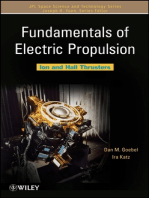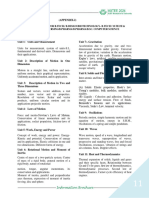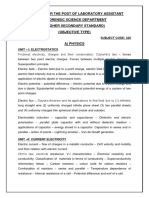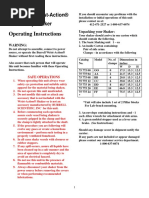0 ratings0% found this document useful (0 votes)
13 viewsTopic List - A Level
This document provides a topic list for an A-Level Physics course covering 12 units:
1) Measurements and their errors
2) Particles and radiation
3) Waves
4) Mechanics and materials
5) Electricity
6) Further mechanics and thermal physics
7) Fields and their consequences
8) Nuclear physics
9) Additional units on turning points in physics focusing on the discovery of the electron, wave-particle duality, and special relativity.
Uploaded by
kajolaradhnasharmaCopyright
© © All Rights Reserved
Available Formats
Download as DOCX, PDF, TXT or read online on Scribd
0 ratings0% found this document useful (0 votes)
13 viewsTopic List - A Level
This document provides a topic list for an A-Level Physics course covering 12 units:
1) Measurements and their errors
2) Particles and radiation
3) Waves
4) Mechanics and materials
5) Electricity
6) Further mechanics and thermal physics
7) Fields and their consequences
8) Nuclear physics
9) Additional units on turning points in physics focusing on the discovery of the electron, wave-particle duality, and special relativity.
Uploaded by
kajolaradhnasharmaCopyright
© © All Rights Reserved
Available Formats
Download as DOCX, PDF, TXT or read online on Scribd
You are on page 1/ 2
A-Level Physics – Topic list
Unit 1 – Measurements and their errors Unit 2 – Particles and radiation
1.1 Use of SI units and their prefixes 2.1 Particles
1.2 Limitation of physical measurements 2.1.1 Constituents of the atom
1.3 Estimation of physical quantities 2.1.2 Stable and unstable nuclei
Unit 3 – Waves 2.1.3 Particles, antiparticles, and photons
3.1 Progressive and stationary waves 2.1.4 Particle interactions
3.1.1 Progressive waves 2.1.5 Classification of particles
3.1.2 Longitudinal and transverse waves 2.1.6 Quarks and antiquarks
3.1.3 Principle of superposition of waves and formation of 2.1.7 Application of conservation laws
stationary waves
2.2 Electromagnetic radiation and quantum phenomena
3.2 Refraction, diffraction, and interference 2.2.1 The photoelectric effect
3.2.1 Interference 2.2.2 Collisions of electrons with atoms
3.2.2 Diffraction 2.2.3 Energy levels and photon emission
3.2.3 Refraction at a plane surface 2.2.4 Wave-particle duality
Unit 4 – Mechanics and materials Unit 5 – Electricity
4.1 Force, energy, and momentum 5.1 Current electricity
4.1.1 Scalars and vectors 5.1.1 Basics of electricity
4.1.2 Moments 5.1.2 Current-voltage characteristics
4.1.3 Motion along a straight line 5.1.3 Resistivity
4.1.4 Projectile motion 5.1.4 Circuits
4.1.5 Newtons laws of motion 5.1.5 Potential dividers
4.1.6 Momentum 5.1.6 Electromotive force and internal resistance
4.1.7 Work, energy, and power Unit 7 – Fields and their consequences
4.1.8 Conservation of energy 7.1 Fields
4.2 Materials 7.2 Gravitational fields
4.2.1 Bulk properties of solids 7.2.1 Newton’s law
4.2.2 The Young modulus 7.2.2 Gravitational field strength
Unit 6 – Further mechanics and thermal physics 7.2.3 Gravitational potential
6.1 Periodic motion 7.2.4 Orbits of planets and satellites
6.1.1 Circular motion
6.1.2 Simple harmonic motion (SHM) 7.3 Electric fields
6.1.3 Simple harmonic systems 7.3.1 Coulomb’s law
6.1.4 Forced vibrations and resonance 7.3.2 Electric field strength
7.3.3 Electric potential
6.2 Thermal physics
6.2.1 Thermal energy transfer 7.4 Capacitance
6.2.2 Ideal gases 7.4.1 Capacitance
6.2.3 Molecular kinetic energy model 7.4.2 Parallel plate capacitor
Unit 8 – Nuclear physics 7.4.3 Energy stored by a capacitor
8.1 Radioactivity 7.4.4 Capacitor change and discharge
8.1.1 Rutherford scattering
8.1.2 Alpha, beta, and gamma radiation 7.5 Magnetic fields
8.1.3 Radioactive decay 7.5.1 Magnetic flux density
8.1.4 Nuclear instability 7.5.2 Moving charges in a magnetic field
8.1.5 Nuclear radius 7.5.3 Magnetic flux and flux linkage
8.1.6 Mass and energy 7.5.4 Electromagnetic induction
8.1.7 Induces fission 7.5.5 Alternating currents
8.1.8 Safety aspects 7.5.6 The operation of a transformer
Unit 12 – Turning points in physics
12.1 The discovery of the electron 12.2 Wave-particle duality 12.3 Special relativity
12.1.1 Cathode rays 12.2.1 Newton’s corpuscular theory of light 12.3.1 The Michelson-Morley
12.1.2 Thermionic emission of electrons 12.2.2 Significance of Young’s double slit experiment
12.1.3 Specific charge of an electron experiment 12.3.2 Einstein’s theory of special
12.1.4 Principle of Millikan’s determination 12.2.3 Electromagnetic waves relativity
of the electronic charge, e 12.2.4 The discovery of photoelectricity 12.3.3 Time dilation
12.2.5 Wave-particle duality 12.3.4 Length contraction
12.2.6 Electron microscopes 12.3.5 Mass and energy
You might also like
- Physics For The Ib Diploma Fifth Edition Cambridge Education Cambridge University Press Samples PDF67% (3)Physics For The Ib Diploma Fifth Edition Cambridge Education Cambridge University Press Samples PDF18 pages
- (K. A. Tsokos) Physics For The IB Diploma (BookFi) 2 PDFNo ratings yet(K. A. Tsokos) Physics For The IB Diploma (BookFi) 2 PDF850 pages
- Cambridge 2010 - Physics - Five Edition - TsokosNo ratings yetCambridge 2010 - Physics - Five Edition - Tsokos849 pages
- Physics Syllabus for Examination of NEET (UG) 2025 PDF DownloadNo ratings yetPhysics Syllabus for Examination of NEET (UG) 2025 PDF Download7 pages
- Kendriya Vidyalaya Tehran Split Up Syllabus 2011 - 2012 Class Xii Subject - Physics Month Name of The Topic Detailed Split Up SyllabusNo ratings yetKendriya Vidyalaya Tehran Split Up Syllabus 2011 - 2012 Class Xii Subject - Physics Month Name of The Topic Detailed Split Up Syllabus5 pages
- Section - A: Physics Syllabus A Pertains To The100% (2)Section - A: Physics Syllabus A Pertains To The12 pages
- Part I Core and AHL 1: Topic 1: Physics and Physical Measurement 250% (2)Part I Core and AHL 1: Topic 1: Physics and Physical Measurement 2129 pages
- Icar Syllabus-Physics, Chemistry, Maths, Bio & Agriculture75% (4)Icar Syllabus-Physics, Chemistry, Maths, Bio & Agriculture26 pages
- Syllabus For BITSAT-2023: Part I: PhysicsNo ratings yetSyllabus For BITSAT-2023: Part I: Physics11 pages
- Unit 4: Work, Energy and Power: JEE MAIN 2022 PHYSICS SyllabusNo ratings yetUnit 4: Work, Energy and Power: JEE MAIN 2022 PHYSICS Syllabus4 pages
- New - Syllabus - Laboratory - Assistant - HSC - TNPSC Exam PDFNo ratings yetNew - Syllabus - Laboratory - Assistant - HSC - TNPSC Exam PDF15 pages
- Methods of Molecular Quantum Mechanics: An Introduction to Electronic Molecular StructureFrom EverandMethods of Molecular Quantum Mechanics: An Introduction to Electronic Molecular StructureNo ratings yet
- Electromagnetism: Maxwell Equations, Wave Propagation and EmissionFrom EverandElectromagnetism: Maxwell Equations, Wave Propagation and Emission4.5/5 (18)
- S. No Basis of Comparison Baseband Transmission Broadband TransmissionNo ratings yetS. No Basis of Comparison Baseband Transmission Broadband Transmission2 pages
- Soalan Matematik Tambahan Kertas 1 SABAHNo ratings yetSoalan Matematik Tambahan Kertas 1 SABAH18 pages
- Template - Quarterly Accomplishment ReportNo ratings yetTemplate - Quarterly Accomplishment Report6 pages
- Pan Pearl River Delta Physics Olympiad 2014: V 10 M/s VNo ratings yetPan Pearl River Delta Physics Olympiad 2014: V 10 M/s V10 pages
- 19th Jan 2025 Digital Classified Doon Weekly Market Epaper-minNo ratings yet19th Jan 2025 Digital Classified Doon Weekly Market Epaper-min31 pages
- royal_enfield_himalayan_450_technical_specificationsNo ratings yetroyal_enfield_himalayan_450_technical_specifications6 pages
- MAN Truck 2012 Emergency Responders GuideNo ratings yetMAN Truck 2012 Emergency Responders Guide86 pages
- Transcription of Echtrae Chonnlai-McConeNo ratings yetTranscription of Echtrae Chonnlai-McCone3 pages

























































































